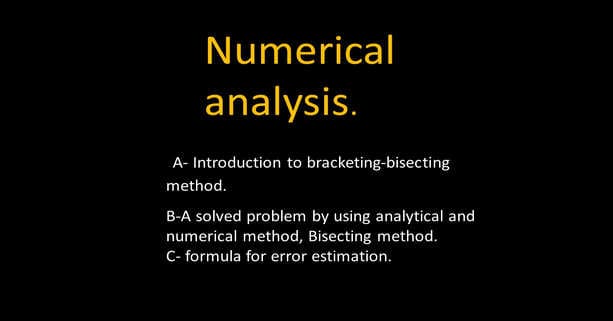Last Updated on October 6, 2024 by Maged kamel
The bisecting method.
What is the bracketing method?
Introduction to bracketing method. The bracketing method is a Numerical method that represents two values of a function having opposite signs; the root will be in between. One example was solved first by using the analytical method, as shown in the next two slides.
The root is the value of x when y=0. The bracketing method depends on two values for f(x): one negative and the other positive. The required root lies between these two brackets, which is why it is called the bracketing method.
Bisecting method.
This is one of the bracketing methods. To find the root point for f(x), the bisecting method can be used by taking the average value of the horizontal distance between points of brackets, substituting it for the function, and determining whether the newly created point is left bracketed or right bracketed.
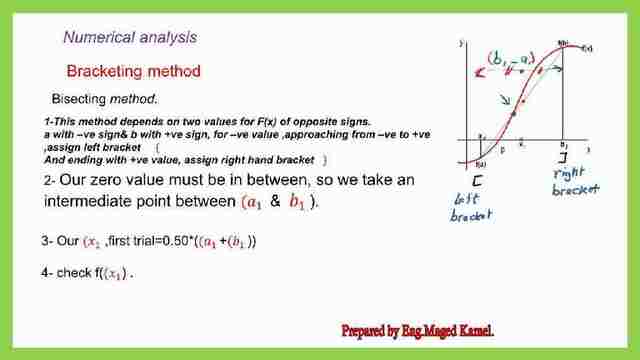
Then, perform a series of bisecting till the value of the function at a certain point approaches zero.
The steps for the bisecting method are continued, as shown In the next slide.
Let us trace the findings after using the bisecting method; when the new F(x) is either positive or -ve v, please refer to the next slide for an illustration.
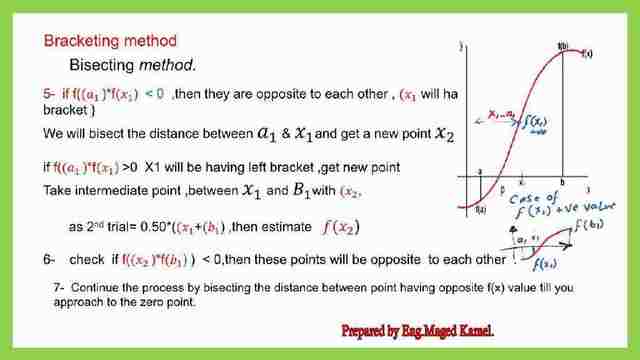
A Solved example for the bisecting method.
This is a reminder of the analytic solution for the solved example. We will find the roots by using synthetic division for f(x)=x^3-6x^2+11x-6. We have three roots for this function. The details of the estimation are shown in the next slide image.
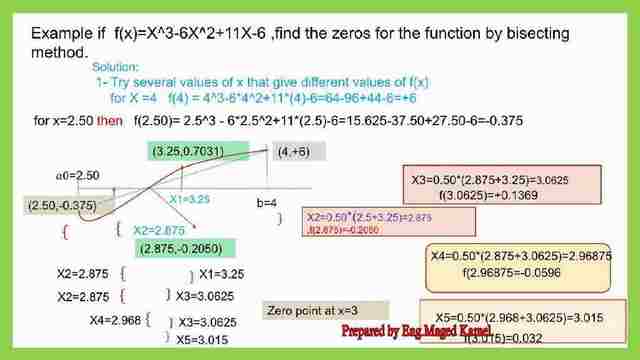
1-Now, let us refer back to our previous example and solve it using the bisecting method. We have x=2.50, which gives a -ve value for F(x); it is a left bracket. While x=4 gives a +positive value for F(x), it is the right bracket.
Take the average value of (2.50+4)=0.50*(6.50)=3.25.
2- Get the value for f(x), when x=3.25, so f(3.25)=2.5^3+11*2.5-6=0.7031. This is a new right bracket.
3- We make check that f(a)*f(b) is >=<0, we want to make sure that we have a negative sign, so (f(2.5)* f(3.25)=-0.375*(+0.7031)=-0.2636. The zero root is in between these two points.
Point (3.25) is a new right bracket.
4—Let us take the average between the left bracket and the right bracket points (3.25,+2.50) as the new x value x2=0.50*(3.25+2.504)=+2.875. Check whether it is a right bracket or a left bracket.
5- Get the value for f(x), when x=2.875, so f(2.875)=2.875
2.875^3+11*2.875-6=-0.20508.This is a new left bracket.
6-We make check that f(a)*f(b) is >=<0, we want to make sure that we have a negative sign, so (f(2.5)* f(2.875)=-0.375*(-0.20508)=+0.076905.
The product is positive. A new Point (x=2.875) is a new left bracket. Then, take the average between this last point(2.875) and our right bracket, x=4. the average is 0.50*(2.875+4)=3.0625.

7-Get the value for f(x), when x=3.0625, so f(3.0625)=3.0625^3+11*3.0625-6=+0.1369.This is a new right bracket.
8-We make check that f(a)*f(b) is >=<0, between the recent left bracket(2.875) and the recent right bracket(3.0625).
We want to make sure that we have a negative sign, so (f(2.875)* f(3.0625)=-0.03. Since the product is negative, the point (3.0625) is a new right bracket point.
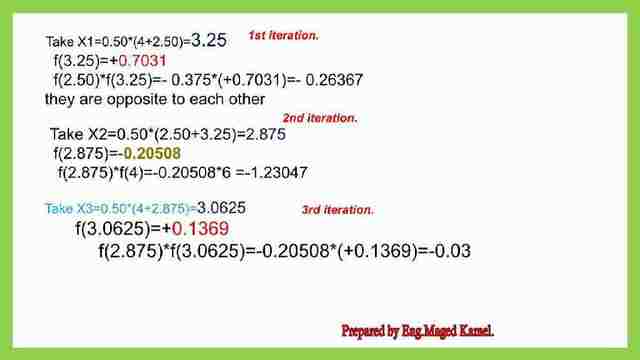
Take the average between (3.0625,2.875)=2.968. Every operation is called an iteration. There are the details of iterations.
8-Get the value for f(x), when x=2.968 so f(2.968)=2.968^3+11*2.968-6=-0.06. This is a new left bracket.
7-We make check that f(a)*f(b) is >=<0, between the recent left bracket(2.968) and the recent right bracket(3.0625).
We want to make sure that we have a negative sign, so (f(2.968)* f(3.0625)=-0.01). The product is negative, so the point (2.968) is a new left bracket point. After 5 iterations, we get the value of x, which will give an approximate solution.
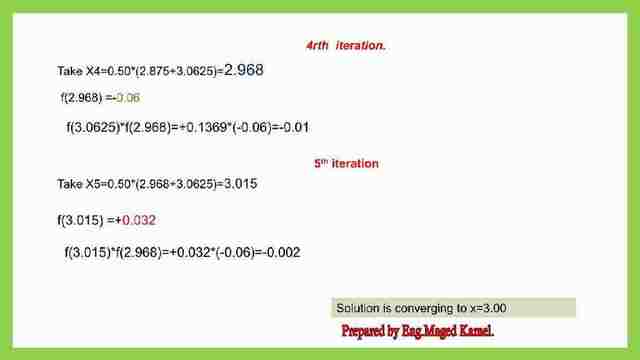
This equation is used for the number of iterations and the relative error.
Now, for the error estimation, the number of iterations n should be bigger or equal to log10 (b0-a0)-log10(e) of the error value the error, for a given error value of 0.001 divided all by (log 10(2).
In our example, a0 = 2.50 and b 0 =4 are the errors of tolerance for the value 0.001.
We can substitute like this: n is bigger or equal to log 10 of (4 -2.50 )* (-3). That is, log value 10 of error 0.001, which is =-3, divided by log 10 of 2 is = (—0.16 6091)—1-(-3))/0.301029, giving us 10.55, which can be approximated to 11.
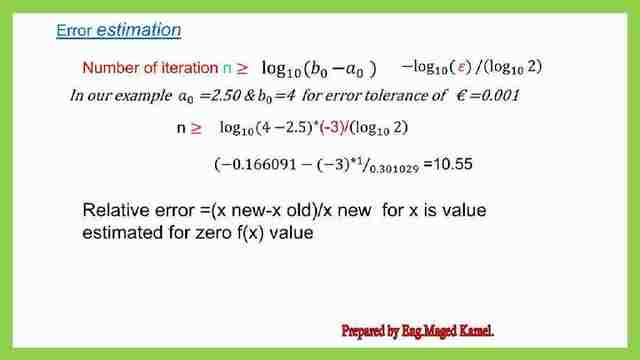
Relative error equals the (x new – x old) / x new. For x, the value is estimated to be zero f(x).
The next topic is the false position, another numerical method for root findings.
This is a good external reference—holistic numerical method.
